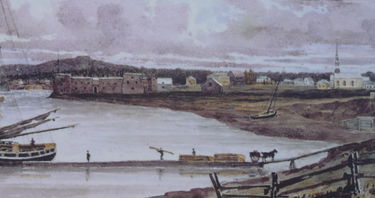Fort Chambly
|
Fort Chambly (1665-1853) - A French Colonial fort established in 1665 in present-day Chambly, Quebec, Canada along the Richelieu River at the foot of Chambly rapids. Named after the French captain Jacques de Chambly, the builder, the fort was abandoned in 1853. It was called Fort de Chambly, Fort Saint Louis and Fort Pontchartrain.
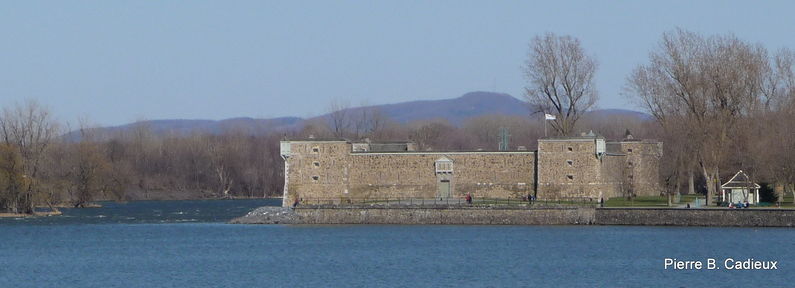 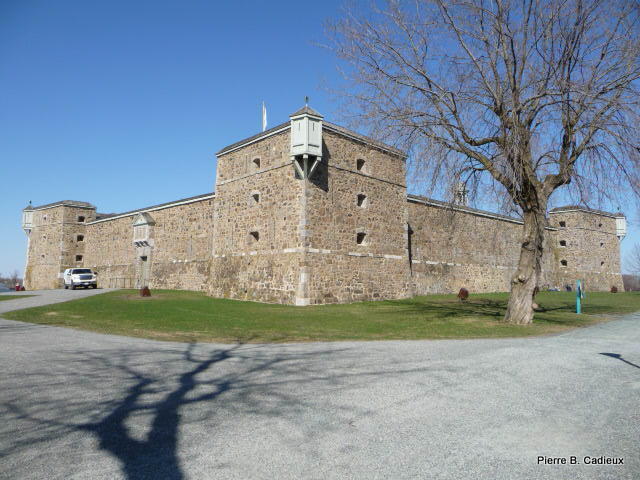 Fort Chambly, the forts 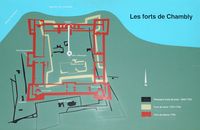 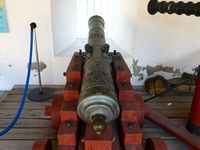 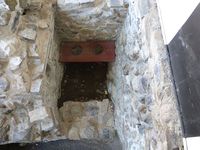 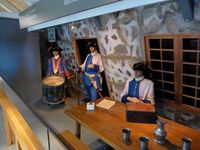 In August 1665, Captain Jacques de Chambly and four companies of the Regiment de Carignan newly arrived in Canada came to the foot of the largest rapids of the Richelieu River, also called Iroquois River, and built a simple log fort, 57 by 57 meters (Fort Chambly I) with a storehouse as a base for a campaign against Iroquois tribes in the Mohawks River Valley later in the winter. It was also called Fort Saint Louis (2) like the Saint-Louis Rapids at the foot it was situated. The French built a few other forts closer to Lake Champlain and the Iroquois Country, Fort Sainte Therese, Fort Saint Jean (2) and Fort Sainte Anne (2). In 1667, after this war, other forts were abandoned and Fort de Chambly kept a garrison of 70 soldiers for a few years as a frontier fort. After 1679, it was more a custom house than a military fort with some time a regular garrison, some time few soldiers to check the fur trade with New York British Colony. In 1686, the palisade was replaced with 400 logs up to 2 feet. In 1687, a watchtower was erected; it served also as a powder house and grain store. The fort and the area were attacked some time by Iroquois warriors in these years. In 1693, 200 logs had to be replaced and the barracks repaired to face a rumored British attack from the south. In winter 1701-1702, a fire burned accidentally the fort. From July to October 1702, a smaller log fort, 31 by 36 meters, was built on the same spot with four bastions, a barrack, 60 by 20 feet, everything in wood (Fort Chambly II). It served as a base for raids against New England. In 1707, a garrison of 20 soldiers occupied the fort. In July 1709, to face the Nicholson Army from the south of Lake Champlain, a new palisade of 3000 logs was added to protect the bakery, stable, and few other buildings constructed outside of the fort; 900 men camped at the fort. Still in war against the British, from fall 1709 to November 1711, a new stone fort was built by Jean-Maurice-Josué Boisberthelot, sieur de Beaucours for 500 soldiers as garrison and 500 others (Fort Chambly III) with settlers and soldiers labor; it was named for a time Fort Pontchartrain for Jérôme de Phélypeaux, comte de Pontchartrain, ministre de la Marine et des Colonies from 1699 to 1715. It served as a base of operation when rumors of invasion came. The looking like a castle fort cannot resist to strong artillery of the time, but authorities thought it was not possible for the British army to bring large guns to the fort. After the war, it served again as a customs house to stop fur smuggling through Lake Champlain with a garrison of 30 soldiers. After the construction of a fort south of Lake Champlain, Fort St. Frederic, in 1731, it served as a depot for that fort with a small garrison (1 lieutenant, 1 sergeant, 6 soldiers in 1742). In the War of 1744-1748, after some raids around the fort, the garrison was raised to 25 soldiers. In the French & Indian War, 1754-1760, the fort became a gathering place for operations against the British south of Lake Champlain. In August 1760, during the siege of Fort Isle aux Noix, the garrison was 50 regular soldiers, 20 militiamen, and a lieutenant. After a very brief siege, Louis Dazemard de Lusignan surrendered to British colonel Derby and 1000 soldiers. In October 1775, at the beginning of the Revolutionary War, British major Joseph Stopford surrendered after the brief siege to James Livingston and 300 Canadians, and major Brown and 50 US soldiers, the vanguard of the US invasion army of the North under General Montgomery. US troops occupied the fort in the winter; a regimental flag of the Seventh Royal Fusiliers believed to have been captured at the fort, was presented by Congress to George Washington, and is now in the Flag Room of the West Point Museum. On June 17, 1776, the defeated US army retired and burned the fort. The fort was restored and occupied by British troops. When the passage from the southern colonies to Lake Champlain eased, the invasion by large armies equipped with artillery rendered the stone fort inaccurate for defense, so it was occupied by a small garrison for the protection of the depot against raids. 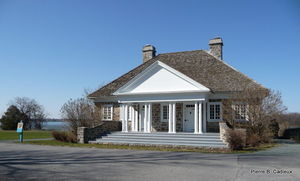 After the Revolutionary War, the British fortification of the border against US invasion and the construction of many roads connecting the south of the border enemy, the fort had a military base role in lieu of a defense one, so an elaborated military camp and headquarter was established there in wartime, 1812-1815, with 40 buildings and 950 soldiers. When the border was fixed and the peace secured with the neighbor, the fort was abandoned. In the Canadian Rebellion of 1837-1838 in Canada, some Canadian Patriotes were jailed in the fort, and after the fort and the camp were occupied and repaired. Around 1849, 60 soldiers still occupied the fort. In 1853, the garrison was retired and the fort abandoned. In 1876, all the buildings, but the fort, were auctioned. 1882-1883, the fort was first restored by J.O. Dion, the keeper. In 1982, Fort Chambly was restored as in 1711 by Parks Canada
History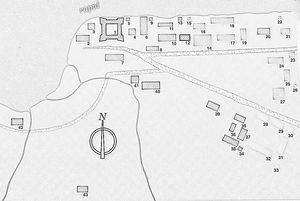 Since the first days of the French colony on the St-Laurent River, the settlers and Native Americans allied were raided by Iroquois from the present days north of New York State. In 1666, the king of France sent the Regiment de Carignan in Canada to submit the Iroquois and to stop raids. For this purpose, they built a line of log forts as bases for the campaign against them. Without a road, the Lake Champlain was the only route to the Iroquois country, since the expedition had to take place in winter; the army needed a closer base for protection and food, Fort Chambly I was built for that purpose at the beginning of the main portage to the lake. In January 1666, 300 French soldiers, 300 Canadians rallied at the fort for the unsuccessful campaign. In September 1666, 600 soldiers, 600 Canadians, and 100 Native American Allies rallied for the second mixed success campaign but with a good result, peace years. In peacetime periods, the only fort not abandoned on this frontier served as a customs house to protect the Canadian fur trade against contraband with New York traders. The fur trade was a lucrative commercial activity and, above all, the best way to attach essential Native American allies. In wartime, the fort was the base for raids against the British enemies. After the construction of forts on Lake Champlain, Fort Chambly became a depot for them.
Current StatusMust See! A restored and animated fort of 1711 can be visited in Fort Chambly National Historic Park.
Sources:
Links: Visited: 29 Jul 2013 (J), 20 Apr 2013 (P)
| ||||||
